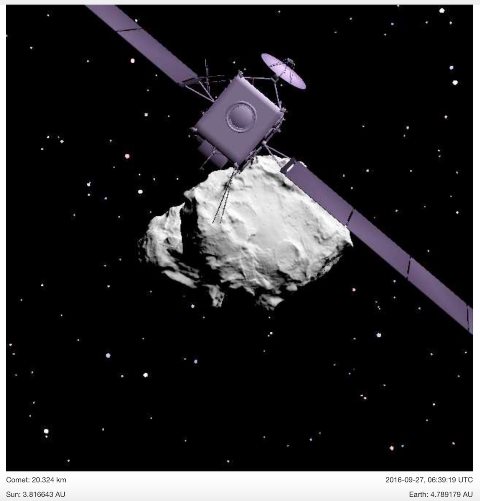
Europe's pioneering spacecraft Rosetta headed for a suicide crash Friday with the comet it has stalked for two years, nearing the end of an audacious quest to unravel the Solar System's mysteries.
Sent by ground controllers on a leisurely, 14-hour freefall, Rosetta launched into a last-gasp spurt of science-gathering on the 19-kilometre (12-mile) journey to its icy comet tomb. "Next stop #67P!" the European Space Agency (ESA) tweeted, using a shortened version of Comet 67P/Churyumov-Gerasimenko's full name.
Rosetta: The end of a space odyssey
It confirmed that the command for Rosetta to exit the galactic wanderer's orbit was received at 2051 Thursday, at a distance of 720 million kilometres (450 million miles) from Earth. The craft was programmed to terminate its 12-year space odyssey at about 1040 on Friday, joining long-spent robot lander Philae on the comet for a never-ending journey around the Sun.
16 days to #CometLanding... find out how & why I have to end my mission on #67P in new #FAQ: https://t.co/WFQtcY8lD7 pic.twitter.com/sukkRWxAIV
— ESA Rosetta Mission (@ESA_Rosetta) September 14, 2016
"We're all very excited," Rosetta project scientist Matt Taylor told AFP at the mission control centre in Darmstadt. Rosetta's science instruments were primed to sniff the comet's gassy coma, or halo, measure its temperature and gravity, and take pictures from closer than ever before.
"In the final descent, we will get into a region that we have never sampled before. We've never been below two kilometres, and that region is where the coma, the comet atmosphere, becomes alive, it's where it goes from being an ice to a gas," said Taylor. With the comet zipping through space at a speed of over 14 kilometres (nine miles) per second, Rosetta was programmed to make a "controlled impact" at human walking speed, about 90 cm (35 inches) per second. Confirmation of the mission's end is expected in Darmstadt around 1120 when Rosetta's signal, which takes 40 minutes to travel, vanishes from ground controllers' computer screens.
"It's mixed emotions," Taylor said of the impending end. While it will all be over for mission controllers, scientists will be analysing the information gleaned for "years if not decades" to come. "We've only just started to get an understanding of what the data is telling us, putting together the pieces of the puzzle," said Taylor.
"We've got this massive puzzle, all the pieces are everywhere, and we need to put them together." The first-ever mission to orbit and land on a comet was approved in 1993 to explore the origins and evolution of our Solar System -- of which comets are thought to contain primordial material preserved in a dark space deep freeze.
China eyes year-long stays for space station astronauts
Rosetta and lander probe Philae travelled more than six billion kilometres over 10 years to reach 67P in August 2014.
Philae was released onto the comet surface in November of that year, bouncing several times, then gathering 60 hours of on-site data which it sent home before entering standby mode. Insights gleaned from the 1.4-billion-euro ($1.5-billion) mission have shown that comets crashing into an early Earth may well have brought amino acids, the building blocks of life. Comets of 67P's type, however, certainly did not bring water, scientists have concluded.






































1713525343-0/WhatsApp-Image-2024-04-19-at-4-09-16-PM-(1)1713525343-0-270x192.webp)
1713525453-0/Henry-Cavill-in-James-Bond-(AI)1713525453-0-270x192.webp)
























COMMENTS
Comments are moderated and generally will be posted if they are on-topic and not abusive.
For more information, please see our Comments FAQ